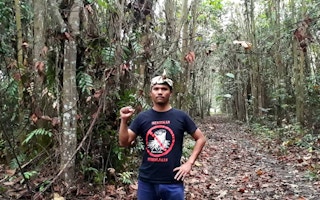“It makes me so sad and angry — some people are pretending we don’t exist,” said Shaq Koyok, an artist and one of Malaysia’s indigenous Temuan people. Koyok is among a growing volley of opposition to the development of a rare tract of rainforest in Selangor, Malaysia’s wealthiest and most highly-urbanised state.
To continue reading, subscribe to Eco‑Business.
There's something for everyone. We offer a range of subscription plans.
- Access our stories and receive our Insights Weekly newsletter with the free EB Member plan.
- Unlock unlimited access to our content and archive with EB Circle.
- Publish your content with EB Premium.
Koyok’s people have lived in and around the Kuala Langat north forest reserve (KLNFR) since at least the 1800s, using it to sustain themselves, their customs and culture. The forest has also provided a lifeline for the Temuans during the Covid-19 pandemic, providing food and water after many lost their jobs. “For us, the jungle is our shopping mall, pharmacy, and grocery store,” said Koyok.
In May, the Selangor state government quietly degazetted — which is to remove the legal protection — more than half of the reserve, with the intention of converting it into a mixed commercial development. State executive councillor Hee Loy Sian has said the development project, which is believed to have been awarded to a company owned by timber, property and palm oil conglomerate Samling Group, is needed to meet future housing needs.
KLNFR once covered 7,2467 ha, when it was gazetted in 1927, but the rare expanse of peat swamp has dwindled to 958 hectares under development pressure ever since.
Under an earlier plan, almost all of the forest was slated for development, but a concession was made following objections to the project for 536 ha, or 54 per cent of the original planned area, to be excised.
A public outcry to new plans to develop prompted Selangor’s chief minister, Datuk Seri Amirudin Shari, to postpone the degazettement on 2 September.
However, delaying the removal of the forest’s legal protection still means that the area will eventually undergo development, said Theiva Lingam, legal advisor, Friends of the Earth Malaysia, one of a number of environmental groups opposing the plan. “They have already degazetted the area. We are calling for the degazettement to be revoked,” she told Eco-Business.
KLNFR sits on 2-4 metres of peat soil and is an important carbon sink. The development would result in the release of 3.2 million tonnes of carbon dioxide, according to a calculation made by green group collective Malaysian Environmental NGOs (MENGO).
As well as a population of 2,000 Temuans, the forest is home to endangered species such as the Malayan sun bear and clouded leopard, and endemic species such as the Selangor pygmy flying squirrel.
The impacts of climate change have been felt domestically with severe floods disrupting three states, including Selangor, last month. MENGO said in a statement on 2 September that the country’s richest state “has taken a step backwards” with a plan to bulldoze an 8,000 year-old forest for property development. Developments such as the one proposed had exacerbated disastrous flooding in the country, according to Lingam.
Selangor should be actively pushing to protect its forests, since it is one of the country’s least forested states, with 31 per cent forest cover — far below Malaysia’s target of maintaining 50 per cent forest cover, which it committed to at the 1992 United Nations Rio Earth Summit, the group said.
Campaigners also object to the manner with which the forest has lost its protection. A public hearing was held to discuss the development in September 2020, but it was held last minute in a remote location, and many could not attend, said Lingam. Even so, more than 45,000 written objections were made to the state government, which were ultimately ignored.
The Selangor government has claimed that the KLNFR was badly degraded, with “no tall trees remaining”, a claim that NGOs say is false. KLNFR is populated with tall, diverse, rainforest trees “of critical conservation importance and must be conserved,” according to the Coalition for the Protection of Selangor Forests (CPSF).
The goverment has proposed protecting other areas “of equivalent or higher value or better forest” to compensate for the loss in Kuala Langat. CPSF said it supported the proposal to gazette these stateland forests, which are located in the districts of Sabak Bernam, Hulu Selangor and Hulu Langat, but these protections should be put in place as well as, not instead of, KLNFR’s gazettement.
CPSF said in a statement on 5 September that the Selangor State Agriculture Corporation (PKPS), a state-owned agro-industry firm which is chaired by the chief minister of the Selangor state government, is liable for prior illegal clearance of peat forest and should be sued. PKPS has taken legal action against CPSF over its statement.
MENGO has called on the Selangor state government to stop any forest clearing in the excised area and reverse its decision. Should the area continue to be degazetted, MENGO has called on investors to refrain from providing financing to develop the area.
Opposition politicians have also entered the debate, calling Selangor’s administration, which is held by the Pakatan Harapan party, “irresponsible” and lacking in integrity for sidelining protests and public objection to the development.
Koyok called the degazettement “mindblowing” coming so soon after the release of a report by Intergovernmental Panel on Climate Change (IPCC) that warned that tropical deforestation must end to avoid the worst consequences of climate change. “I don’t know how anyone can sleep with this decision,” he said. “It gives our country such a bad reputation. It’s hard to believe they think they can get away with it.”










